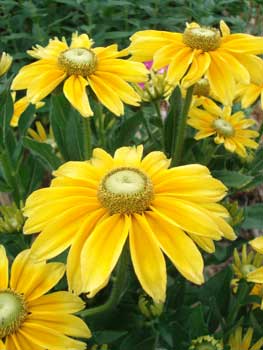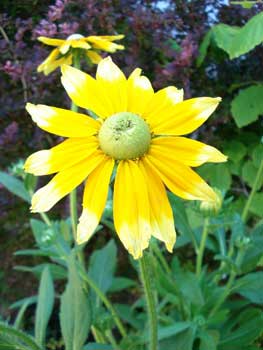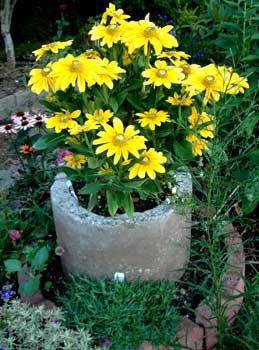
'Prairie Sun'
Gloriosa Daisy
The daisy follows soft the sun,
And when his golden walk is done,
Sits shyly at his feet.
He, waking, finds the flower near.
"Wherefore, marauder, art thou here?"
"Because, sir, love is sweet!"
-Emily Dickinson
1830-1886
Rudbeckia hirta 'Prairie Sun' has become a standard cultivar, & a good fill-in plant because so intensely, reliably flowerful mid-summer to first frost. 1830-1886
Here in the Northwest, it's sold almost invariably as a perennial, which is a cheat, as it's biennial, & if planted as a mature clump is not at all likely to return for a second year, having already seen it.
 It annoys me that it's persistently, dishonestly misrepresented as a perennial, but other than that, it's not a flower to fault.
It annoys me that it's persistently, dishonestly misrepresented as a perennial, but other than that, it's not a flower to fault.I needed a big aggressive annual for a tall container which will be, in the future, populated only by appleberries. The appleberry starts were tiny; in order that the container not look practically empty its first year, I added 'Prairie Sun' in it. When its short life is over, two colors of appleberries will be filling the container.
It does sometimes self-seed but not likely to do so on Puget Sound, as our winters are too wet for the seedlings to take hold. They start easily indoors & come spring seedlings can be placed in their permanent locations after the last threat of frost. In more southerly gardens, or inland, it can naturalize without much attention.
 This so-called Coneflower or Black-eyed Susan has no black eye. Its center is cream colored instead of black, & flat rather than a cone. So it is often called by the alternate name of Gloriosa Daisy.
This so-called Coneflower or Black-eyed Susan has no black eye. Its center is cream colored instead of black, & flat rather than a cone. So it is often called by the alternate name of Gloriosa Daisy.The blooms on 'Prairie Sun' are numerous, a good five inches across, generally less than three feet tall. If it has any fault at all, it would be that it looks rather like those pots of daisies or mums nursery-dressed & sold as gifts for hospital bedsides or cemeteries, when to me the nicest flowers have a "cottage garden" naturalness.
Depending on the grower, the appearance of this big yellow daisy is so varied that it surprises me all these strains are labeled 'Prairie Sun.' The solid dark yellow-orange blooms shown first above (in July) are from the clump growing in the aforementioned container. But another clump, shown second in August, is from a clump we had a couple years ago; it produced flowers that were a slightly paler yellow & each petal tip was creamy white.
So it seems the cultivar is a mite unstable & being seed-grown, extremely variable, though always good looking.
A butterfly &p bee attractant in summer, then in autumn attracting small birds that peck at the seedheads. It wants full sun, with regular moderate watering through summer, in perfectly draining soil. It'll do almost as well in bright shade but is apt to lodge so would need staking. It'll lodge if soil is too rich, too. It should not be too crowded with other perennials as the density of its foliage can attract powdery mildew if lacking sufficient air circulation.
Continue to:
Rudbeckia hirta 'Goldilocks' double yellow coneflower